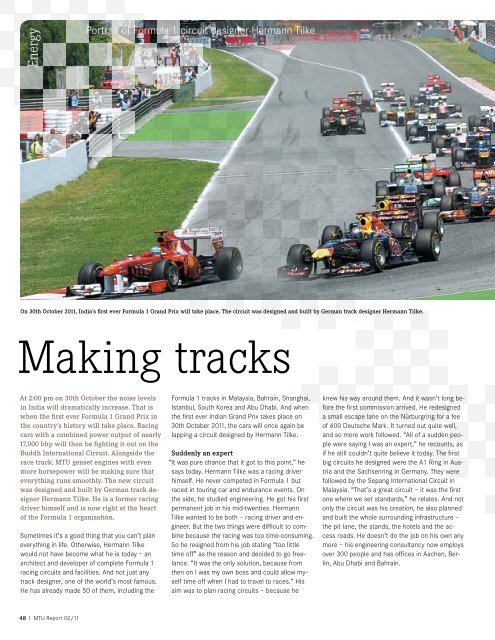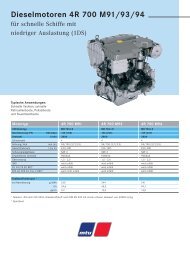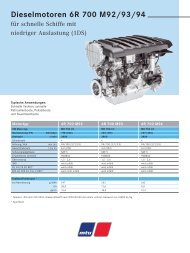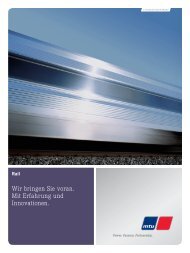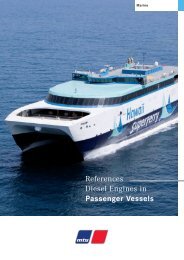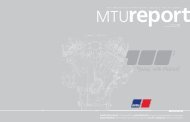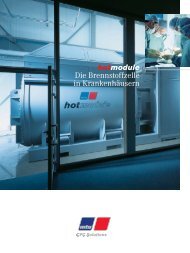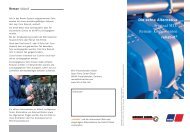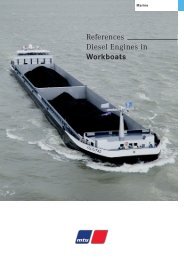Create successful ePaper yourself
Turn your PDF publications into a flip-book with our unique Google optimized e-Paper software.
Energy<br />
At 2:00 pm on 30th October the noise levels<br />
in India will dramatically increase. That is<br />
when the first ever Formula 1 Grand Prix in<br />
the country’s history will take place. Racing<br />
cars with a combined power output <strong>of</strong> nearly<br />
17,000 bhp will then be fighting it out on the<br />
Buddh International Circuit. Alongside the<br />
race track, <strong>MTU</strong> genset engines with even<br />
more horsepower will be making sure that<br />
everything runs smoothly. The new circuit<br />
was designed and built by German track designer<br />
Hermann Tilke. He is a former racing<br />
driver himself and is now right at the heart<br />
<strong>of</strong> the Formula 1 organization.<br />
Sometimes it’s a good thing that you can’t plan<br />
everything in life. Otherwise, Hermann Tilke<br />
would not have become what he is today – an<br />
architect and developer <strong>of</strong> complete Formula 1<br />
racing circuits and facilities. And not just any<br />
track designer, one <strong>of</strong> the world’s most famous.<br />
He has already made 50 <strong>of</strong> them, including the<br />
48 I <strong>MTU</strong> Report 02/11<br />
Portrait <strong>of</strong> Formula 1 circuit designer Hermann Tilke<br />
On 30th October 2011, India’s first ever Formula 1 Grand Prix will take place. The circuit was designed and built by German track designer Hermann Tilke.<br />
Making tracks<br />
Formula 1 tracks in Malaysia, Bahrain, Shanghai,<br />
Istanbul, South Korea and Abu Dhabi. And when<br />
the first ever Indian Grand Prix takes place on<br />
30th October 2011, the cars will once again be<br />
lapping a circuit designed by Hermann Tilke.<br />
Suddenly an expert<br />
“It was pure chance that it got to this point,” he<br />
says today. Hermann Tilke was a racing driver<br />
himself. He never competed in Formula 1 but<br />
raced in touring car and endurance events. On<br />
the side, he studied engineering. He got his first<br />
permanent job in his mid-twenties. Hermann<br />
Tilke wanted to be both – racing driver and engineer.<br />
But the two things were difficult to combine<br />
because the racing was too time-consuming.<br />
So he resigned from his job stating “too little<br />
time <strong>of</strong>f” as the reason and decided to go freelance.<br />
“It was the only solution, because from<br />
then on I was my own boss and could allow myself<br />
time <strong>of</strong>f when I had to travel to races.” His<br />
aim was to plan racing circuits – because he<br />
knew his way around them. And it wasn’t long before<br />
the first commission arrived. He redesigned<br />
a small escape lane on the Nürburgring for a fee<br />
<strong>of</strong> 600 Deutsche Mark. It turned out quite well,<br />
and so more work followed. “All <strong>of</strong> a sudden people<br />
were saying I was an expert,” he recounts, as<br />
if he still couldn’t quite believe it today. The first<br />
big circuits he designed were the A1 Ring in Austria<br />
and the Sachsenring in Germany. They were<br />
followed by the Sepang International Circuit in<br />
Malaysia. “That’s a great circuit – it was the first<br />
one where we set standards,” he relates. And not<br />
only the circuit was his creation, he also planned<br />
and built the whole surrounding infrastructure –<br />
the pit lane, the stands, the hotels and the access<br />
roads. He doesn’t do the job on his own any<br />
more – his engineering consultancy now employs<br />
over 300 people and has <strong>of</strong>fices in Aachen, Berlin,<br />
Abu Dhabi and Bahrain.


